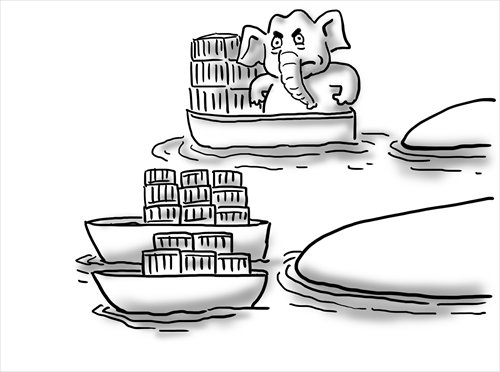HOME >> OP-ED
In Iran’s Chabahar, India seeks leverage point over Pakistan, China
By Shi Lancha Source:Global Times Published: 2016-6-5 14:46:55

Illustration: Liu Rui /GT
Indian Prime Minister Narendra Modi recently concluded his maiden 2-day sojourn in Iran, where he finalized a long-awaited contract with Tehran for Chabahar Port, a seaport of strategic importance on the southeastern coast of Iran. During his visit, Modi also met with Iran’s President Hassan Rouhani and Afghan leader Ashraf Ghani in a rare engagement concerning the trilateral transport and transit pact. The pact will presumably provide the legal framework to operate trade corridors with Chabahar as its main hub. Although the construction of Chabahar Port began in 1982 and India first showed interest as early as 2002, it was not until Modi’s recent visit that inroads were made into realizing the project.
Actually, Chabahar is just the tip of the iceberg of India’s geostrategic ambitions. Besides building new berths and upgrades to Chabahar, what interests New Delhi more is a comprehensive scheme that can reshape India’s geopolitics to the northwest and extend its influence further into the Middle East, Central Asia and the Trans-Caucasus. To this end, India has recently committed $400 million in steel to construction of the railway connecting Chabahar and Zahedan, near Afghan border.
Together with the road from Delaram, Afghanistan to Zaranj at the Iran-Afghanistan border, as well as the road from Zaranj through Zahedan to Chabahar, India expects to gain access to Afghanistan’s “Garland Road,” which links major Afghan cities including Herat, Kandahar, Kabul and Mazar-e-Sharif.
Although New Delhi ostensibly highlights economic considerations, such as facilitating trade along the International North-South Transport Corridor and extracting minerals, natural gas and oil from the region, its larger geostrategic calculations and ambitions are obvious. A direct gateway through Pakistan provides the shortest and the most economical access for India to enter Afghanistan and Central Asia. However, due to long-standing mistrust, Islamabad is reluctant to grant India access.
The sea-land route of Chabahar Port is designed to bypass Pakistan. With the new route, some Indian strategists suggest that India can take further advantage of its ties with Iran and Afghanistan and gain new leverage and positioning while reducing Pakistan’s political and economic influence in the region.
Besides bypassing the overland blockage, India also views its investment in Chabahar as a counterweight against Pakistan’s Gwadar Port, a Chinese-funded deep sea port 72 kilometers east of Chabahar. India harbors suspicions – and anxieties - that Gwadar provides China a key post to monitor Indian naval activity in the Persian Gulf and a dual-use base for Chinese ships and submarines. For example, there is popular belief that Gwadar is just another unfriendly stronghold along the so-called “string of pearls” that China is building to choke India’s activities in the Indian Ocean and beyond. These influences perpetuate a “Sino-Indian rivalry” and zero-sum game narrative that leads New Delhi to counter its involvement in Chabahar.
Although India’s expectations of Chabahar and the sea-land route are running high, especially following the lifting of international financial sanctions against Iran, major challenges remain. India may not be able to meet its generous offers and high-sounding rhetoric. As the “Make in India” campaign continues, India’s limited public financial resources are largely prioritized for domestic use. Given India’s perennial financial weakness, it may take New Delhi longer to fulfill these multibillion-dollar overseas commitments.
As preeminent political commentator Raja Mohan notes, institutional incompetence may be another major hurdle for New Delhi. While previous international circumstances had made engaging with Iran difficult, India’s internal incoherence may produce big concerns. Given India’s rather porous track record in delivering promises, internal problems loom large despite a consensus being hammered out with international shareholders. After all, like many other items on New Delhi’s long wish-list of reforms and development, the plan with Iran depends much on Modi’s limited political capital.
Iran may not always align itself with India’s geostrategic goals. China is also crucial to Tehran’s core interests. Iran never publicly articulated its opposition to the Sino-Pakistani project in Gwadar. Instead, it had aided the project by providing fresh water and fuel. After all, Tehran’s priority is to boost economic development in its relatively backward eastern regions, while geostrategic rivalries are consigned to take a backseat. In this regard, if India expects too much from Iran, it is bound for disappointment.
Chabahar port may benefit all those concerned, including China and Pakistan, as it improves connectivity in region and aligns with China’s “Belt and Road” initiative. However, if the rivalry narrative and zero-sum game thinking continue to prevail in New Delhi, these efforts are likely to be counterproductive.
The author is a visiting scholar at Tsinghua University. opinion@globaltimes.com.cn
Posted in: Viewpoint